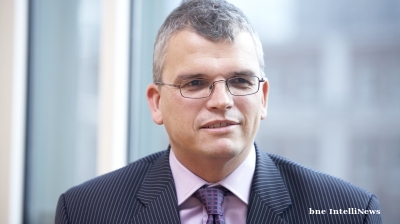Improvement in the corporate capital flows in November supports a constructive near-term view on the ruble and adds to the list of arguments in favour of a rate cut
Corporate capital outflow slows in November
According to preliminary balance of payments, Russia's current account surplus suffered a minor contraction from $8.0bn in October to $6.5bn in November (11M19 surplus reached $71.6bn), while net private capital outflow (by banks, non-financial companies, and households) slowed materially from $6.7bn in October to $2.1bn in November (11M19 net capital outflow is $33.7bn).
Improvement in the corporate capital account was the primary support factor to the ruble exchange rate, which appreciated from $/RUB64.3 in October to 63.9 in November, as the FX purchases by the central bank of Russia and Ministry of Finance remained virtually unchanged at $4.3-4.5bn in October-November, and the net portfolio inflows into the local currency state bonds (OFZ) in November haven't really matched October's extremely strong $3.1bn result.
This balance of payment configuration represents a noticeable change vs. the typical performance of 2019 when ruble strength was assured only by portfolio inflows. While the reasons for the improvement have yet to be understood, the decline in the capital outflows at first glance is a positive development for the ruble exchange rate in the near term, supporting our constructive expectations of $/RUBstaying around the 64.0 level in 4Q19-1Q20.
An outperformance of this target is possible if the generally favourable global market mood, including optimism about global trade negotiations, persist, while risk factors include possible re-emergence of US-Russia sanction rhetoric, including the upcoming discussion of the Defending American Security from Kremlin Aggression Act, or Daska at the US Senate committee scheduled for 11 December.

Arguments in favour of another rate cut
Improvement in the balance of payments structure, even temporary, can serve as an additional argument in favour of another rate cut at the upcoming central bank meeting on 13 December.
We have recently changed our near-term view on the year-end key rate from 6.5% (unchanged) to 6.25% (a 25 bp cut from the current level) following the lower than expected CPI reading of 3.5% for November and continued improvement in households' inflationary expectations, which combined with the high base effect should push CPI growth even lower to 3.2% y/y in December 2019 and 2.3-2.5% y/y in 1Q20.
In the meantime, we maintain the expected terminal key rate at 6.0% - the lower bound of the equilibrium range, given the persisting medium and long-term uncertainties regarding the inflationary and exchange rate trends. We expect the central bank commentary on 13 December to focus on the limited downside of further key rate cuts.
-
Dmitri Dolgin is the Chief Economist, Russia, at ING in Moscow. This note first appeared on ING’s “Think” portal here.
Content Disclaimer: This publication has been prepared by ING solely for information purposes irrespective of a particular user's means, financial situation or investment objectives. The information does not constitute investment recommendation, and nor is it investment, legal or tax advice or an offer or solicitation to purchase or sell any financial instrument. Read more
Opinion

COMMENT: Ukraine’s coming financial storm
“A crisis is drawing ever closer. It will break in Ukraine, but it won’t begin on the frontlines, where the country’s battle-weary brigades continue to impose a brutal cost on the Russian invader. A crisis is coming.

BEYOND THE BOSPORUS: Performance postponed. Hotly anticipated “CHP” trial pushed into October
Every Turk up and down the country has an opinion on what Erdogan is up to.

COMMENT: Europe’s summer of humiliation
This summer started with optimism around trade deals and progress in Ukraine, but quickly unravelled. Trade uncertainty is back, the war drags on with rising casualties, and Europe is now grappling with a raft of political crises.

INTERVIEW: The rags-to-riches rise of Freedom Holding Corp's Timur Turlov
As he rang the Nasdaq exchange bell to start trading in his company’s shares, the childhood dream of this Wall Street movie fan from a poor Moscow suburb had come true.
.jpeg)


